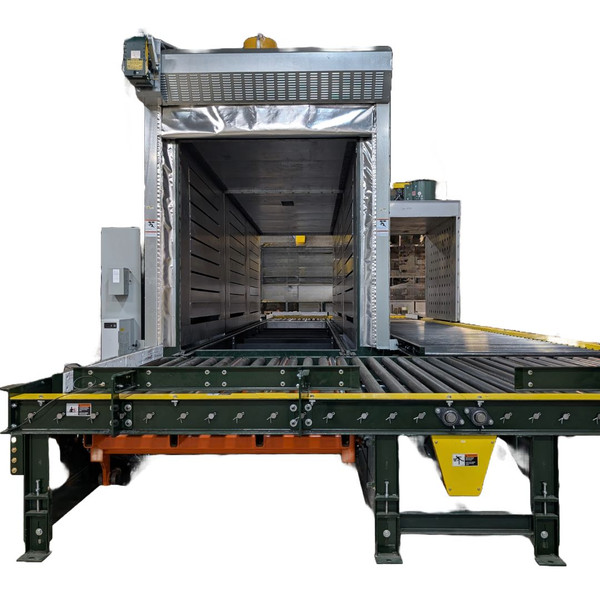Selecting the right size for your industrial oven isn’t just a matter of picking something large enough to fit your product. It’s a strategic decision that involves careful consideration since it impacts production efficiency, energy usage, product quality, and future scalability. Choosing an oven that’s too small can create costly bottlenecks, while an oversized oven will waste energy and valuable floor space.
Below we’ve listed the factors we believe go into the decision for sizing an oven that aligns with your process requirements, space limitations, and business goals.
- Application Requirements
Your industrial oven is designed for your specific purpose. The first step in determining size is to clearly define your application.
- What are you processing? Whether it’s metals, plastics, composites, electronics or something else, the material’s thermal properties will influence the oven’s design and size.
- What’s the process? Curing, drying, annealing, paint baking, heat treating, etc. may require different temperature profiles and dwell times.
- Are there regulatory standards? Industries like aerospace, automotive, medical, and food have specific standards that can influence design, heating uniformity, and documentation requirements.
- Batch vs. Continuous
The operational mode is another major driver of oven size.
- Batch ovens are loaded with a fixed amount of product, processed, and then unloaded. They’re best for low to medium production volumes or varied product types.
- Continuous ovens use conveyors to move product through the heating zone. These are designed for high-volume operations with consistent product flow.
The operational mode dictates how the load is to be handled and therefore how large the oven needs to be to meet throughput requirements.
- Load Size and Volume
The most critical factor in determining oven size is, of course, how much is going into the oven.
- Measure the dimensions of the product (length x width x height) and determine how it will be arranged in the oven. Will it be on racks? Trays? Hanging?
- Consider the total load volume per cycle. Will you need to process multiple parts simultaneously?
- When measuring, allow space for product clearance/maximum part size around the product which is critical for uniform heating and avoid hot spots.
- Temperature Requirements
Your processes’ required temperature profile plays a role in determining oven size and design.
- What is the minimum and maximum operating temperatures?
- Does your process require quick ramp-up or cool-down rates?
- Are there temperature uniformity requirements across the load?
Products with high thermal mass may need more time and energy to reach desired temperatures, affecting oven size.
- Production Throughput
How much product do you need to process in any given unit of time?
- What is your required output per minute, hour, or shift?
- Figure in dwell time.
- Consider loading and unloading time.
Your oven must be large enough to keep pace with your desired production schedule without creating a bottleneck.
- Facility Constraints
This is an important one! Make sure the oven fits comfortably into your facility.
- Measure floor space and ceiling height
- Check for door and hallway clearance. How are you bringing the oven in?
- Make sure you have access to electricity, gas, ventilation, and exhaust
- Is there enough room to load and unload safely?
- Airflow and Heat Distribution
Interior layout and clearances are influenced by airflow patterns which are essential to even heating.
- Horizontal or vertical airflow are determined by your product’s geometry and load setup.
- Also consider temperature uniformity requirements across the chamber.
The interior of the oven must be designed for unobstructed airflow. This includes upsizing to accommodate ducts or fans.
- Future Scalability
Think long-term. It pays to plan for the future now.
- Are there plans to increase production in the next few years?
- Does an expandable design make sense for future expansion?
- Would a slightly larger unit now save on future replacement or retrofitting expenses down the line?
Scaling up too late can result in costly downtime or emergency purchases.
- Regulatory and Safety Considerations
Regulatory compliance can influence both size and safety.
- Do you need explosion-proofing, HEPA filtration, or cleanroom compatibility?
- Are there fire codes or NFPA requirements you must follow?
- Does the oven require special safety systems like gas leak detection or auto shut-down?
These factors can add space-consuming components to the oven design which need to be considered in sizing.
- Work with an Experienced Oven Manufacturer
Sizing your industrial oven isn’t just about “measurements”. It’s a balance of engineering, process requirements, and business strategy.
A reputable oven manufacturer like Horizon Performance Technologies can:
- Analyze your process and product requirements
- Recommend custom solutions
- Provide detailed dimensional drawings
- Demonstrate energy cost and resource savings
- Guide you through installation and long-term maintenance
Determining the right size for your industrial oven involves more than just fitting your product inside. It’s about aligning heat requirements, production goals, facility constraints, and long-term growth. Following the steps above you’ll be well positioned to choose an oven that delivers efficient, reliable, and safe performance for years to come. Get started by contacting Horizon today.


